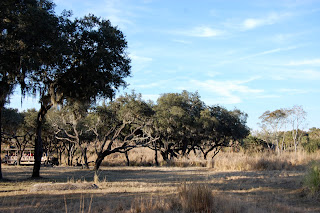In the story of Harambe, the Harambe Wildlife Reserve is said to be 800 square miles. In actuality, Kilimanjaro Safaris is not quite that large, but it does cover a substantial amount of land. At about 140 acres, the entire Magic Kingdom Park could fit within the borders of this single attraction, with room to spare. That includes 100 acres for the safari itself and 40 acres north of the ride path (visible from some areas, but not accessible by the trucks) that help create the illusion that the savanna goes on forever.
Close inspection of a map of the Harambe Wildlife Reserve reveals many of the places actually visited during the course of the Kilimanjaro Safaris adventure, along with a few which have been thrown in just to make it appear as though the reserve extends beyond the borders of the theme park.
Safari vehicles leave the Departure Base to the south and head through the forest toward the Safi River, a popular spot for herds of hippopotami. The Serikali Bridge (below) is one of the landmarks pointed out on the map. The word "serikali" means "government." This was a bridge funded by the state to provide easier access to the savanna areas of the reserve. The bridge has definitely seen better days, though. It creaks and groans under the weight of the Tembo Trucks, as a pile of crocodiles waits below.
Once across the river, the trucks head into the Ndege ("bird") Hills for a spectacular view of the savanna and one of the reserve's ancient Baobab trees (artificial, remember?).
Although the Baobabs on the savanna are fake, the vast majority of the foliage here is real and was transplanted to the site during the construction of Disney's Animal Kingdom. One exception is this stand of trees (below). Known internally as "Tree Save," the oaks in this area of the safari were already here. To make them fit the African landscape, the oak trees were pruned to look more like acacia (the giraffes do their part to keep them that way).
On a trip through the savanna, everything appears completely authentic, but there is plenty of artifice. Elements have been created here and there to help give the area a look that is more distinctly African than Floridian.
The termite mounds (below), for example, are concrete but made to look just like the real thing. Termites create the mounds with a combination of earth and saliva, and they can get as hard as rock. Elephants and other animals like to rub up against them to, as Warden Mutua would put it, "scratch their itchy backsides!"
The artists at Walt Disney Imagineering also sculpted the roadway on which the safari vehicles travel. It only looks like dirt or mud, but is actually reinforced concrete. Each Tembo Truck weighs something in the neighborhood of sixteen tons and would sink into a real earthen road.
The roadway is particularly interesting in the places where it's made to appear as though the trucks are trudging through shallow water. Here, the sculpted ruts not only add a dramatic look, but also serve a purpose. They keep the "show water" through which the vehicles travel separate from the treated water that is part of the animals' environment.
There are also several places along the path where the road appears to go in different directions. Some of these alternate routes serve an operational purpose while others don't, but they're all accounted for on the map of the reserve. Riding through, be on the lookout for these roads, along with markers pointing the way to places like Tumbili Tented Camp or Wingu Kopjes.
Soon, the safari trucks pass the red clay pits and into elephant territory. Disney's Animal Kingdom has one of the largest and finest facilities for African elephants in the world, with more than six acres of natural habitat. That acreage is spread across three different onstage areas which can be connected or separated. The bridge above, for example, leads from one area to another and can be closed off if needed.
This functionality has allowed the Animal Programs team to conduct groundbreaking studies in elephant communication. At times, it has also enabled having a matriarchal herd in one area and a lone bull in another, just as they would be in the wild. As a result of this and other efforts, Disney's Animal Kingdom has been extraordinarily successful in breeding African elephants.
Moving on past the Zamani Rock Paintings ("zamani" translates as "former" or "ancient"), the trucks emerge onto the Kifaru Plains, home to a population of white rhinos (is it any surprise that "kifaru" is Swahili for "rhinoceros").
At the southern edge of the plains are Wingu ("cloud") Kopjes. Pronounced "copies," kopjes are rounded rock outcroppings found in the savannas of eastern Africa. Wingu Kopjes are a popular destination for safari guides, since they're often frequented by lions.














nice pictures.. i like it very much its so nice and beautiful..
ReplyDelete